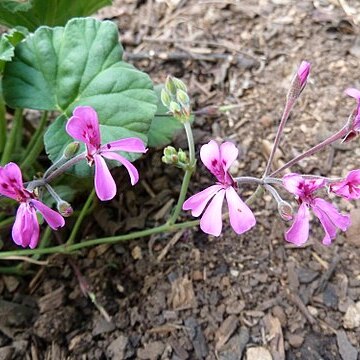Erect or decumbent, evergreen subshrub, ±0.2-0.4 m (seldomly 1 m) high when in flower, seldomly branched from base. Root system: a tap root with a complex system of tubers, sprouting. Stems with elongated or much reduced internodes; young stems herbaceous, grey green, velutinous; older stems leafless, woody, brown, glabrous, covered with remains of stipules and sometimes petioles. Leaves crowded and rosulate or loosely spaced, simple, greyish to silvery green; lamina reniform or ovate-cordate, sometimes with 3-5 shallowly incised lobes, (18-)30-50(-70) x (18-)25-45(-80) mm, obtuse, base cordate, margin crenulate, crenate, dentate or finely lobed, adaxially velutinous, abaxially lanose interspersed with glandular hairs; petiole (5-)25-90(-130) mm long, densely pubescent and glandular, sometimes interspersed with long soft hairs; stipules free, 6-12 x 1-2 mm, lanceolate to narrowly triangular, acute, membranous, adaxially and abaxially pubescent, persistent. Inflorescence: a flowering branch with numerous pseudo-umbels, branched, internodes elongated, indumentum glandular, foliage leaves reduced; each pseudo-umbel with 4-12 light pink to purple flowers; peduncle 35-120 mm long, unbranched, scantily villous to pubescent. Involucral bracts lanceolate to ovate, acute, membranous, 4-7 x 13 mm, adaxially glabrous, abaxially scantily pubescent. Pedicel of varying length (2-12 mm long), shorter than hypanthium, glandular and adpressed pubescent. Hypanthium red, (15-)20(-45) mm long, indumentum as on pedicel; base prominently thickened. Sepals 5, lanceolate to narrowly triangular, adaxially glabrous, abaxially indumentum as on pedicel, red with pink margins, 4-5 x 1-3 mm, posterior sepal straight, other four basally reflexed through 180°. Petals 5, pink to magenta; posterior two with dark feather-like markings, grouped together, spathulate, truncate to retuse, 12-15 x 2-3 mm, apically recurved through 90°, anterior three oblanceolate to obovate, truncate to retuse, 12-15 x 3-5 mm, narrowly clawed, basally recurved through 60°. Stamens: 1 fertile, of 3 different lengths, filaments pink, shorter than sepals; anterior filament acuminulate; anthers purple, posterior 3 smaller than anterior 4; pollen orange; staminodes 3. Ovary 3 mm long, pear-shaped, densely villous, green. Style. 2 mm long, glabrous, red. Stigma with 5 recurved branches, 1-2 mm long, red. Mericarps 5, base 4-5 mm long, tail 11-15 mm long.
More
Erect or decumbent subshrub, 0.2-0.4 m high. Leaves crowded and rosulate or loosely spaced; lamina reniform or ovate-cordate, shallowly lobed, base cordate or reniform, margins finely toothed; adaxially velutinous, abaxially lanose interspersed with glandular hair; petioles relatively long. Inflorescences: branches with many pseudo-umbels, each with 4-12 light pink to purple flowers; peduncles 35-120 mm long. Hypanthium red, 15-45 mm long. Sepals 5, lanceolate to narrowly triangular. Petals 5, pink to magenta; posterior 2 with red markings, spathulate, apically recurved; anterior 3 oblanceolate to obovate. Stamens 7 fertile; anthers pink; pollen orange; staminodes 3. Flowering time Oct.-May. Mericarps 5.
Shrublet to 40 cm, with tuberous roots. Leaves reniform, usually shortly hairy, 3-7 cm diam. Flowers to 15, ± 20 mm diam., bright pink; hypanthium 15-45 mm long, much longer than pedicel.

